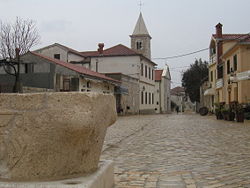- Nin, Croatia
-
Nin — Town — 
Coat of armsthe Nin municipality within the Zadar County Location of Nin within Croatia Coordinates: 44°14′N 15°10′E / 44.233°N 15.167°E Country Croatia County Zadar Government - Mayor Emil Ćurko (HDZ) Population (2001) - Total 1,256 4,603 (municipality) Time zone CET (UTC+1) - Summer (DST) CEST (UTC+2) Postal code 23210 Area code(s) 023 Website grad-nin.hr Nin (Latin: Aenona or Nona) is a town in the Zadar county of Croatia, population 1,256 (2001), total municipality population 4,603 (2001).
Nin was historically important as a centre of a Christian Bishopric in the Middle Ages. Up to the abolition and Latinization imposed by King Tomislav in the first half of the 10th century, Nin was the centre of the autonomous Croatian branch of the Church. Nin was also the seat of the Princes of Dalmatia. The Bishop Gregory of Nin (Grgur ninski) was an important figure in the 10th century Church politics of Dalmatia.
Contents
History
A small town near Zadar, Nin has a very rich and tumultuous history. Its location is intriguing; the heart of Nin is its historical center on an islet only 500 meters in diameter. Nin is situated in a lagoon on the eastern shore of the Adriatic Sea, surrounded by natural sandy beaches and linked with the mainland by two stone bridges from the 16th century. According to historians the area of Nin appears to have been settled 10000 years ago. The present-day town on the islet developed 3000 years ago and is one of the older towns on the eastern Adriatic. The area of Nin was colonized by immemorial people of the Mediterranean.
Since the 9th century B.C. the civilization of the Illyrian tribe of Liburnians[1] was present before the Romans came, who had a strong sea and trade center called Aenona. The rich archeological finds prove strong sea links with Greece and the Hellenistic world: recent explorations revealed a rarity, a very well preserved Byzantine mosaic on the floor of a Roman villa.
The Church of the Holy Cross in Nin originates from the 9th century
The Croats colonized Nin at the beginning of the 7th century. The first Croatian state community was formed at the end of the 8th and beginning of the 9th century. Nin was the first Croatian royal town, with its period of glory being from the 7th to the 13th centuries. In the 9th century Nin became the seat of the first Croatian bishop. Bishops from Nin played a great role in the country's religious, a cultural and a political sense. Their struggle for national language (Glagolitsa) was a struggle for Croatian independence. Significant rulers connected with the history of Nin include Prince Višeslav, Prince Branimir, King Tomislav, King Petar Krešimir IV, King Zvonimir.
At the time of Turkish war, Nin was on the battle-field. After the selling of Dalmatia to Venice (1409), Nin came under the control of Venice. Since then began its destruction; it was economically exploited but not protected militarily. The town was destroyed twice. The first destruction was 1571 and the second on 28 April 1646. The Venice government gave an order to burn the town and destroy it systematically. According to historians, the Venice government sacrificed Nin and left the burnt town to the Turks to save the town of Zadar. Monument, churches, and the king's and bishops palaces in Nin were destroyed and have never been renewed.
The economic development of Nin began after World War II. Since 1969, Nin has been developing as a tourist destination. Nin today is historical and tourist town which looks for its developing in valorization of historical heritage. In recent years, many monuments have been restored. Because of the importance of Nin in the history of Croatia, tourists visit from Croatia and elsewhere in Europe. They come especially to visit two symbols of the old town: the church of Holy Cross from the 9th century called “the smallest cathedral in the world” and the coronation church.After 1980 near Nin a high power mediumwave broadcasting station was built.
Broadcasting Station
Near Nin, there is the most powerful broadcasting station of Croatia. It works on 1134 kHz with an output power of 600 kW ( before its destruction in 1991 1200 kW) and can be easily received in whole Europe at night time. The transmitter, which went in service in 1984 used before 1991 as antenna 4 guyed mast radiators insulated against ground with a height of 132 metres. In 1991 the station was destroyed during the Croatian independent war. Its missing signal was the most characteristic physical evidence of the war in Croatia. After the end of the war it was restored, but first not in fully extend: only 2 of its masts were rebuilt and the transmitter has only 600 kW output power. The other 2 masts were rebuilt several years later. [1]
References
- ^ The Illyrians by J. J. Wilkes,1992,ISBN 0631198075,Page 71,"... Place-names from the Illyrian territories add little to our knowledge of the Illyrian language. The recurrent element -ona, for example, Aenona (Nin), Blandona (south Liburnia), Emona (Ljubljana), Narona (Vid), Scardona (Skradin near Sibenik), Salona (Solin near Split), ..."
External links
- official site
- Nin tourist site
- Nin information
- St. Nicholas of Nin Chapel, XIth century
- Nin photos
- Awarded "EDEN - European Destinations of Excellence" non traditional tourist destination 2010
Subdivisions of Zadar County Cities and towns Municipalities Categories:- Cities and towns in Croatia
- Populated coastal places in Croatia
- Former capitals of Croatia
- Populated places in Zadar County
Wikimedia Foundation. 2010.






